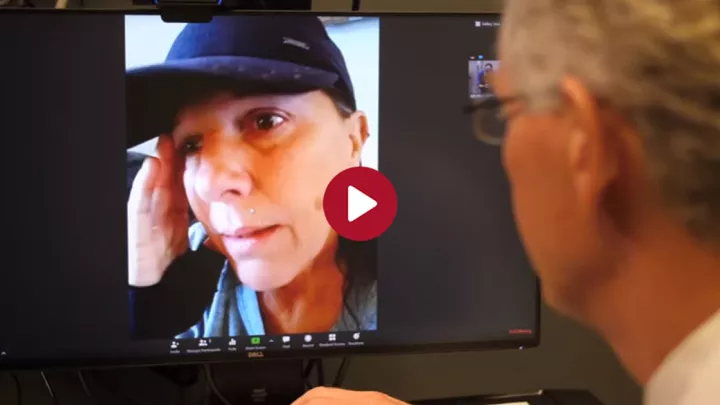Think you might have a UTI or yeast infection? Get help with a quick telehealth visit

If you are experiencing itching, burning or general discomfort "down below," there's a good chance you may have a urinary tract or yeast infection. Determining the exact cause of your symptoms and getting appropriate treatment is critical to preventing the condition from getting worse.
"Both a urinary tract and yeast infection require diagnosis from a health care provider to ensure you are treating the right problem," says Ashley Barajas, NP, Nebraska Medicine nurse practitioner with the Nebraska Medicine Virtual Care Clinic. "Without appropriate treatment, a urinary tract infection could travel up the urinary tract and damage the kidneys, making it become a much more serious condition."
While symptoms of a UTI and yeast infection are similar, there are some subtle differences. Through a quick telehealth call, a medical expert can differentiate between the two and prescribe an appropriate medication.
What is a UTI?
A urinary tract infection is an infection of the urinary system that can include the kidneys, ureters, bladder and urethra. It is caused when bacteria enter the urinary tract, oftentimes from intercourse or bacteria from the rectum. Unmanaged diabetes can also lead to UTIs.
Common UTI symptoms include:
- A burning sensation when urinating
- Urge to urinate more frequently or urgently
- Cloudy and strong-smelling urine
- Pelvic pain
- Red, pink or cola-colored urine
UTI treatment and prevention
Treatment to clear a UTI requires antibiotics prescribed by your health care provider.
To help reduce your risk for a UTI, take these steps:
- Drink cranberry juice. Although studies have not been conclusive that cranberry juice can prevent UTIs, it can't hurt to add this to your diet if you are prone to UTIs, says Barajas
- Drink lots of water. Drinking lots of water will help flush out bacteria from your urinary tract to prevent infections from setting in
- Urinate after intercourse to help flush out bacteria that may have entered the urinary tract during intercourse
- Avoid douching, scented soaps and deodorant sprays. These can interfere with the good bacteria that help keep bad bacteria from growing
- Evaluate your birth control method. Birth control such as diaphragms and unlubricated or spermicide-treated condoms can facilitate bacterial growth
What is a yeast infection?
A yeast infection is a fungal infection of the vagina and vulva that is often caused when there is a disruption of the normal balance of healthy bacteria in that area. It can be triggered by unmanaged diabetes, overuse of feminine products like douching, bubble baths, over washing the vaginal area, or wearing tight-fitting, non-breathable clothing. Some people are also more prone to yeast infections during their period.
Common yeast infection symptoms include:
- Burning and itching in the vagina and vulva
- Burning sensation while urinating or during intercourse
- Thick, white discharge that looks similar to cottage cheese
- Watery vaginal discharge
Yeast infection treatment and prevention
Over-the-counter anti-fungal medications for three to seven days will usually clear a yeast infection. These medications need to be inserted into the vaginal canal. A single-dose oral medication may also be prescribed.
"If your yeast infection doesn't clear up with treatment, there's a chance you could have a sexually transmitted infection or bacterial infection that requires other treatment," says Barajas. "This will require an in-person clinic visit to complete an examination of the vagina and test the discharge."
To prevent yeast infections, avoid:
- Tight-fitting clothing
- Douching and use of scented feminine products
- Washing the vagina with soap. Use water only
- Time in hot tubs and very hot baths
- Using antibiotics when possible
- Wearing wet clothes, swimsuits and workout attire too long
Can I treat my UTI or yeast infection myself?
There are over-the-counter creams you can use to help relieve itching and burning, but they will not make the infection go away. Learn about more home remedies for UTIs.
Treatment for yeast infections typically involve over-the-counter medications such as a vaginal insert or a pill. However, medical advice from a health care provider is recommended to ensure you are using the appropriate treatment, says Barajas.
Immediate Care Video Visits
Discussing these types of topics can often be uncomfortable, and it can be tempting to avoid seeking medical advice. Or maybe you just don't have time to fit in a clinic visit.
The good news is that you can now schedule an Immediate Care Video Visit or E-Visit from the comfort of your home with a Nebraska Medicine provider to diagnose your condition and prescribe medications if necessary.
To submit an E-Visit, you will need to log in to your One Chart | Patient account, click on E-Visit from the menu bar, and then fill out and submit a questionnaire about your symptoms. A provider will review your information and recommend treatment or next steps within 24 hours.
You can complete an Immediate Care Video Visit without a One Chart | Patient account through this link. Just scroll to the bottom, and select the red "Start an Immediate Care Video Visit without an account" button. If you have a One Chart | Patient account, you can log in through OneChartPatient.com, or the Nebraska Medicine app, and access Immediate Care Video Visits from the menu.
If you schedule a telehealth visit for a UTI or a yeast infection, you provider will ask you the following questions to get to the bottom of your symptoms:
- Are you having pain with urination?
- Are you having vaginal discharge?
- Are you having vaginal itching?
- Do you have blood in your urine?
- Do you have a fever?
- Are you experiencing vomiting?
- Are you experiencing back pain?
"With an Immediate Care Video Visit, you can usually talk to someone via a video chat within 15 minutes of requesting the appointment," says Barajas.
A variety of conditions can be diagnosed during a telehealth visit, including fever, nausea, allergies, asthma, back pain or cough. See a complete list of conditions that can be treated via telehealth.
View all our convenient scheduling options at NebraskaMed.com/Care







